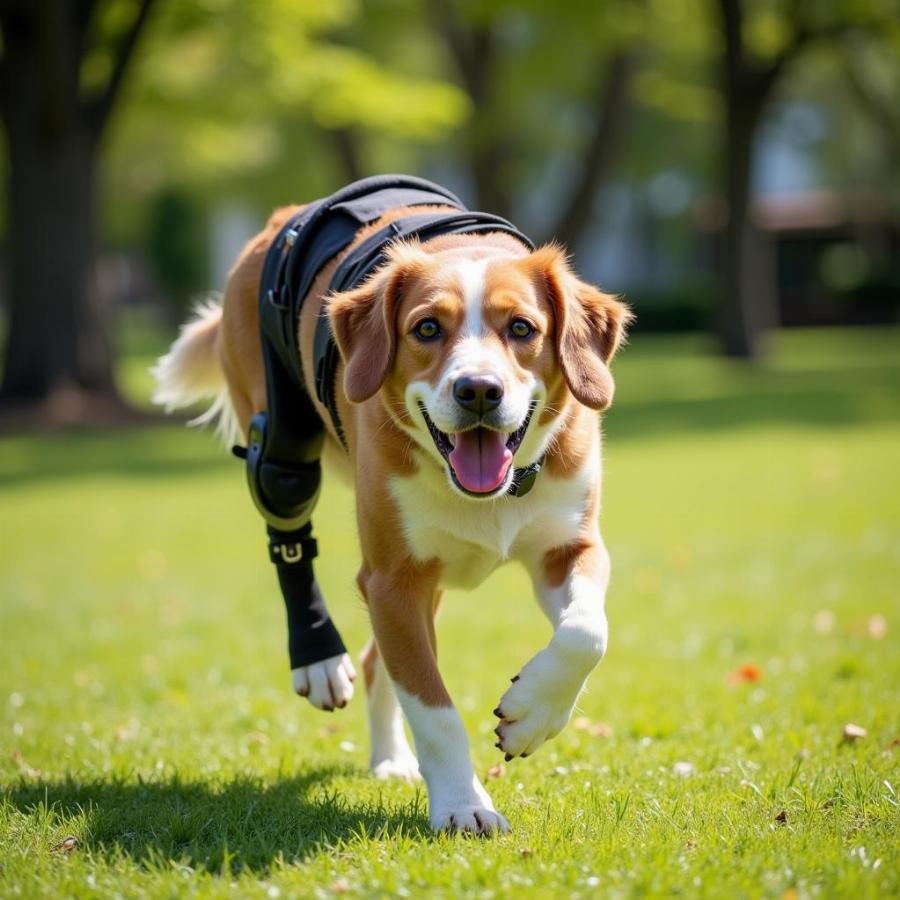Braces for dogs are becoming increasingly common as a way to manage various mobility issues. This comprehensive guide will delve into the world of canine braces, exploring their types, uses, benefits, and how to choose the right brace for your furry friend. We’ll cover everything from diagnosing the need for a brace to ensuring a comfortable fit.
Understanding the Need for Canine Braces
Just like humans, dogs can experience joint pain and mobility problems due to injuries, arthritis, or developmental conditions. Braces provide support and stability, helping dogs regain mobility and improve their quality of life. They can be particularly helpful for older dogs suffering from arthritis, or younger dogs with conditions like hip or elbow dysplasia. Is your dog showing signs of stiffness, limping, or difficulty moving? These could be indicators that your dog might benefit from a brace. Consult with your veterinarian to get a proper diagnosis and discuss whether braces are a suitable option.
Types of Dog Braces
Several types of braces are available, each designed for a specific purpose:
- Front Leg Braces: front leg braces for dogs with elbow displacia These support the carpal (wrist) and elbow joints, aiding in conditions like carpal laxity and elbow dysplasia.
- Hip Braces: hip dysplasia braces for dogs These braces stabilize the hip joint and are often used for dogs with hip dysplasia or arthritis.
- Back Leg Braces: hip braces for dogs These can help with injuries to the hock (ankle) or knee, providing stability and support.
- Back Support Braces: These are designed to stabilize the spine and can be helpful for dogs with intervertebral disc disease (IVDD).
Choosing the Right Brace for Your Dog
Selecting the right brace is crucial for effectiveness and your dog’s comfort. Consider the following factors:
- Veterinarian Recommendation: Always consult with your veterinarian. They can diagnose the specific issue and recommend the most appropriate type of brace.
- Size and Fit: Ensure the brace fits correctly. A poorly fitting brace can be uncomfortable and ineffective. Measurements should be taken according to the manufacturer’s instructions.
- Material and Design: Look for braces made of breathable and durable materials. The design should allow for a comfortable range of motion while providing adequate support.
- Dog’s Activity Level: Consider your dog’s activity level when choosing a brace. More active dogs might require a more robust and supportive brace.
Benefits of Using Dog Braces
 Chó cảnh đeo niềng chân đang chơi
Chó cảnh đeo niềng chân đang chơi
Using braces for dogs can offer numerous benefits:
- Pain Relief: Braces can help alleviate pain by stabilizing injured joints and reducing pressure on affected areas.
- Improved Mobility: By providing support, braces can help dogs regain mobility and move more comfortably.
- Enhanced Recovery: Braces can support healing after injuries or surgery, aiding in a faster recovery.
- Increased Quality of Life: By reducing pain and improving mobility, braces can significantly enhance a dog’s overall quality of life.
Getting Your Dog Used to a Brace
Introducing a brace should be a gradual process. Start with short periods of wear and gradually increase the duration. Positive reinforcement, such as treats and praise, can help your dog associate the brace with positive experiences.
Braces for Specific Conditions
- Arthritis: Braces can provide support and stability to arthritic joints, reducing pain and improving mobility. braces for dogs back legs are often used in this case.
- Hip Dysplasia: Hip braces can help stabilize the hip joint and alleviate pain associated with hip dysplasia.
- Elbow Dysplasia: Elbow braces can support the elbow joint and reduce stress on affected areas.
- Cruciate Ligament Injuries: Knee braces can provide stability and support following a cruciate ligament injury.
Conclusion
Braces for dogs can be a valuable tool in managing various mobility issues. They offer numerous benefits, including pain relief, improved mobility, and enhanced recovery. By understanding the different types of braces, choosing the right brace for your dog’s specific needs, and following proper usage guidelines, you can help your furry friend live a more comfortable and active life. Remember to always consult with your veterinarian before using a brace on your dog.
FAQ
- Are braces uncomfortable for dogs? With proper fitting and acclimation, braces should not be uncomfortable.
- How long can a dog wear a brace? This depends on the individual dog and the specific condition. Your veterinarian can provide guidance on appropriate wear times.
- Can braces cure mobility issues? Braces are typically used to manage, not cure, mobility problems.
- How do I clean my dog’s brace? Follow the manufacturer’s instructions for cleaning.
- Are there alternatives to braces? Your veterinarian can discuss alternative treatment options, such as physical therapy or medication.
Further Reading
- Do you know about braces for dog’s teeth? Learn more in our article about teeth braces for dogs.
Beaut Dogs: Your Canine Companion Resource
Beaut Dogs is your go-to resource for all things dog-related, offering expert advice and valuable insights into the world of canine care. From breed information to health tips, we provide comprehensive and reliable information to help you care for your beloved companion. When you need assistance, don’t hesitate to contact us via Email: [email protected] to receive detailed and accurate answers from Beaut Dogs.